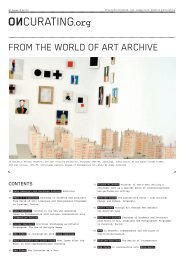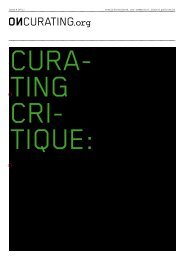Create successful ePaper yourself
Turn your PDF publications into a flip-book with our unique Google optimized e-Paper software.
055 Issue # 11/11 : PublIc Issues<br />
Derya: When I read the Artforum text by Claire Bishop<br />
(Bishop 2006), I w<strong>as</strong> intrigued by some of her arguments.<br />
1. She argues that Oda Projesi strives to minimalise<br />
authorship, that this is a conceptual gesture, and that<br />
this move is used by Oda Projesi to develop an ethics<br />
b<strong>as</strong>ed on the rejection of the authorial position (Bishop<br />
2006, pp. 180–181).<br />
2. She claims that aesthetic judgement is not something<br />
that concerns Oda Projesi and that, for the art collective,<br />
even the concept of aesthetics is a dangerous word that<br />
h<strong>as</strong> to be kept out of the discussion (Bishop, p. 180).<br />
3. She further argues that the group openly conceives its<br />
work <strong>as</strong> antagonistic or activist (Bishop 2006, p. 180).<br />
4. Referring to Grant Kester's conversation Pieces, she<br />
writes: "for (...) supporters of socially engaged art,<br />
the creative energy of participatory practices rehumanizes<br />
or at le<strong>as</strong>t dealienates a society rendered numb and frag-<br />
mented by the repressive instrumentality of capitalism.<br />
But the urgency of this political t<strong>as</strong>k h<strong>as</strong> led to a situa-<br />
tion in which such collaborative practices are automati-<br />
cally perceived to be equally important artistic gestures<br />
of resistance: there can be no failed, unsuccessful, un-<br />
resolved, or boring works of collaborative art because<br />
all are equally essential to the t<strong>as</strong>k of strengthening the<br />
social bond" (Bishop 2006, p. 180).<br />
5. For Bishop, in collaboration-b<strong>as</strong>ed art practices,<br />
creativity is reduced to collective action and to sharing<br />
ide<strong>as</strong> (Bishop 2006, p. 180).<br />
6. She says that unlike the practices of artists like<br />
Thom<strong>as</strong> Hirschhorn, who deliberately makes visible the ex-<br />
ploitative character of his relation to his collaborators,<br />
Oda Projesi expresses a kind of generosity that h<strong>as</strong> a<br />
tendency to turn its collaborators into volunteering and<br />
harmonious participants (Bishop 2006, p. 181).<br />
7. Finally, there is also the problem of how we should<br />
conceive the concept of community. Bishop does not elaborate<br />
on this issue in her 2006 essay but instead she discus-<br />
ses it at length in her previous Antagonism and Relational<br />
Aesthetics (Bishop 2004). There is no reference to Oda<br />
Projesi in this earlier text, but one might find a similar<br />
criticism about collaborative art in general. She claims<br />
that such an artistic approach tends to comprehend community<br />
<strong>as</strong> something unified, requiring the mutual identi-<br />
fication of its members and relying on harmony rather than<br />
conflict or contradiction. However, she argues, community<br />
can be transformed into something democratic and political<br />
only if it is understood <strong>as</strong> a platform for continuous<br />
antagonism.<br />
Neighbouring<br />
Seçil: The issue of community is rather significant here.<br />
I prefer to define it <strong>as</strong> an ensemble of people whose<br />
qualities establish a whole. The motif of artists working<br />
with community should lead us to reflect upon what<br />
reducing community merely to a material for art involves.<br />
Could we say that Oda Projesi proposes the concept of the<br />
neighbour rather than that of community? I am not only<br />
referring to our experiences and positioning in the Galata<br />
neighbourhood in Istanbul. What I am trying to indicate is<br />
the need to reverse the process in which both the neigh-<br />
bourhood in which we spent eight years and our neighbours<br />
are reduced to a mere cate-<br />
gory by some of those seeking<br />
to describe our work. Does<br />
theorisation necessarily<br />
entail squeezing a group of<br />
people into the term community?<br />
Neighbouring is a<br />
state of becoming which h<strong>as</strong><br />
to be metaphorically substantiated<br />
and constantly<br />
re-formed. A unified and<br />
harmonious structure is<br />
always already unrealistic<br />
and impossible; or if any<br />
such claim exists, it is<br />
perhaps constructed retro-<br />
spectively, or amounts<br />
to pretension. For instance,<br />
we were once invited to an<br />
exhibition project in Bristol<br />
and the organisers <strong>as</strong>ked<br />
us to work with that group<br />
or that community. We suggested<br />
working with people<br />
who form a collectivity upon<br />
meeting us and each other,<br />
and who then disperse once<br />
the project h<strong>as</strong> finished,<br />
rather than working with a<br />
predefined group of people.<br />
Our proposal w<strong>as</strong> rejected.<br />
Community is indeed a frag-<br />
mented, procreative, disharmonious,<br />
and conflictual<br />
structure. That's why it<br />
can survive and produce new<br />
thinking. Therefore, I would<br />
propose a definition of<br />
Oda Projesi <strong>as</strong> a project in-<br />
volving neighbours rather<br />
than a pre-defined community<br />
Derya: I suppose what you<br />
mean here is not physical<br />
proximity but something else.<br />
So not only your neighbour<br />
next door, right? What exac-<br />
tly do you have in mind?<br />
Something like states of be-<br />
coming, in a world that is<br />
multiple, antagonistic, and<br />
fluid?<br />
Özge: To understand where<br />
one stands, one h<strong>as</strong> to look<br />
at those who stand nearby.<br />
The word neighbour refers to<br />
people who are sharing the<br />
same space, coincidentally<br />
or not, that is, who are<br />
face-to-face. This sense of<br />
sharing shapes the course<br />
of life. We don't construct<br />
our lives alone. The power<br />
of architecture emerges<br />
at the boundary lines that<br />
separate lives from each<br />
other. If this boundary re-<br />
fers to the walls of a flat<br />
or a house, we can argue<br />
that the situation intensi-<br />
fies in certain spaces and<br />
c<strong>as</strong>es more forcefully than<br />
in others. Oda Projesi, on<br />
the other hand, is perhaps<br />
willing to soften and er<strong>as</strong>e<br />
these sharp divisions. Neigh-<br />
bourhood is actually a<br />
notion that relies on spa-<br />
tiality; it is something that<br />
shapes space; it requires<br />
everyone to define the<br />
boundaries of private life<br />
<strong>as</strong> they want to: some neigh-<br />
bours prefer to remain<br />
unseen and hidden and that<br />
creates particular uses<br />
of space, where<strong>as</strong> some others<br />
develop more extroverted<br />
structures. For instance,<br />
some people use curtains,<br />
some do not; and these deci-<br />
sions depend on to what<br />
extent people want to relate<br />
to the exterior world and<br />
the people who are physically<br />
nearby. In that sense,<br />
establishing a relationship<br />
with one's neighbours is<br />
perhaps the first step to<br />
becoming part of the public<br />
sphere. Therefore, for<br />
Oda Projesi, it is perhaps<br />
important to discuss publicprivate<br />
divisions, and how<br />
architectural paradigms<br />
shape these divisions along<br />
with different modes of<br />
neighbourhood. This includes<br />
not only two persons being<br />
neigbours but also two urban<br />
spaces being neighbours...<br />
Derya: Here, I perceive<br />
a positive significance that<br />
you attach to the process of<br />
becoming part of the public<br />
sphere. This reminds me of a<br />
perspective that presumes<br />
the state of being public <strong>as</strong><br />
something automatically good<br />
– which I find problematic.<br />
Would definitions like be-<br />
coming collective, collective<br />
living, or commonality<br />
perhaps be more suitable in<br />
this context?


![Download as PDF [10.6 MB]](https://img.yumpu.com/4266533/55/500x640/download-as-pdf-106-mb.jpg)

